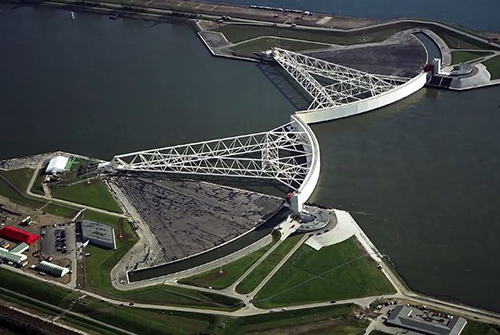Fletcher Rallies Support of Ike Dike


Fletcher: “The costs of the potential human and environmental disaster of a storm surge along the Texas Gulf Coast and up the Houston Ship Channel are too great to bear.”
**WATCH Fletcher Testify on Ike Dike During House Transportation and Infrastructure Committee Hearing HERE**
Congresswoman Lizzie Fletcher (TX-07) testified in support of the Texas Coastal Spine project, sometimes referred to as the Ike Dike, and called for it to be included in President Biden’s proposed American Jobs Plan.
A key priority of the American Jobs Plan is strengthening infrastructure in vulnerable coastal areas, making the Texas Gulf Coast one of the most critical areas of focus for this package. Fletcher noted that the federal government has spent tens of billions of dollars for post-disaster recovery from catastrophic storms in recent years, highlighting both the need and economic savings preventative infrastructure investments like this project would save taxpayers. She called the Ike Dike plan, which has received initial review by the Army Corps of Engineers, a “national priority” to protect the country’s economic and national security interests.
“The President has told us that this is the moment to reimagine and rebuild—and to invest in the future of our country,” Congresswoman Fletcher remarked in her testimony. “That’s why our plan for a transformative infrastructure should include the proposed Texas Coastal Spine, also known to us in Houston as the Ike Dike.”
Fletcher noted that the Ike Dike “is a plan to prevent a potential human and environmental catastrophe unlike any country this country has ever seen.”
The proposed project is a man-made coastal barrier to protect Galveston Bay and the Greater Houston area from devastating storm surges. It involves extending Galveston Island’s existing seawall and constructing massive floodgates at the entrance to Galveston Bay.
Thank you, Mr. Chairman for the opportunity to testify today about the needs and priorities for infrastructure investment in Houston and Harris County, Texas.
Of course, like people across the country, we have many needs and many opportunities for investment, and I look forward to working with the Committee to identify and develop transit and transportation infrastructure in the third-fastest growing—and already the third largest—county in the country, as well as other investments that will help make our infrastructure more resilient, including our power grid and our water conveyance infrastructure, and to make our entire coastal region more resilient—which is where I will focus my testimony today.
As we discuss the American Jobs Plan, building on the important work of this committee, the President has told us “this is the moment to reimagine and rebuild” and to invest in the future of our country, in part, by investing in infrastructure that will be resilient to floods, storms, and other threats, and not fragile in the face of these increasing risks.
Back home in Texas, we have been doing just that for nearly a decade—imagining, designing, and working to address the challenges of the past with an eye to the future.
And the time to do that is now.
That is why our plan for transformative infrastructure should include the proposed Texas Coastal Spine, also known to us as the “Ike Dike.”
While Hurricanes are a fact of life along the Gulf Coast, in a little more than a decade, our region has sustained increasingly dangerous and destructive Hurricanes—causing loss of life, destruction of property, and hundreds of billions of dollars in damages.
- Hurricane Ike in 2008, from which this project takes its nickname, became the third-costliest storm in U.S. history, causing $30 billion in losses to the Houston region and killing 84 people.
- In 2015 and 2016, back-to-back 500-year floods, on Memorial Day and Tax Day, flooded more than 12,000 structures.
- The following year, another 500-year flood named Hurricane Harvey killed 68 people and caused more than $125 billion in damages in the region.
The scientists have told us that these storms will increase in size and frequency as a result of climate change—and we believe them.
We have seen it with our own eyes.
But we also know that, as bad as all these storms were, it could have been worse. It could have been what the Houston Chronicle has described as a “20-foot wall of water smashing into tanks filled with oil and chemicals, transforming a bay teeming with life into a pit of poison.”
So, what I am talking about now, what Texans have been talking about for a decade, is a plan to prevent a potential a human and environmental catastrophe unlike any this country has ever seen.
That is because of the unique conditions that make this transformative plan to extend Galveston Island’s existing seawall and construct massive floodgates at the entrance to Galveston Bay project a national priority.
This investment is in our national economic interest.
The Houston region, home to more than seven million people, is also home to the Port of Houston, the busiest port in the country by total tonnage, and home to one of the largest, if not the largest, concentration of refining and petrochemical complexes in the world. Essential products like gasoline, jet fuel, plastics, fertilizers, cleaning chemicals are all made here.
The economic damage to the United States in the event of a catastrophic impact storm surge up the ship channel would have dire economic consequences across the country.
We’ve seen a preview, when these facilities were closed for days as a result of Hurricane Harvey and this year’s Winter Storm, we saw prices skyrocket across the country.
This investment is in our national security interest.
The Texas Gulf Coast is responsible for 32% of the refining capacity for the entire country. Estimates are that 40% of our nation’s jet fuel that we rely on for our national security is refined there—the consequences for loss of that capacity, as well as other fuels, cannot be understated as it relates to our national security.
This investment is timely.
We have seen broad community support to take transformative action from across the community. Texas state legislators, led by Representative Gene Wu, have asked the White House to include it in the infrastructure package. We should hopefully see a final chief’s report from the Army Corps of Engineers this year on the study.
This investment is smart.
Studies have shown that for every dollar spent on pre-disaster mitigation, the Federal government saves seven dollars or more in future damages. In light of the costs I mentioned for our recent storms, the return on investment is plain.
This investment is also a major undertaking. Estimates place the cost of the project at $26 billion, this project will require significant coordination between local entities and federal agencies. And we are ready to do it.
This is the moment to do it
I will end my testimony with the observation made in my very first hearing as a member of this Committee in the 116th Congress: there are costs to doing nothing—and the costs of this potential human and environmental disaster of a storm surge along the Texas Gulf Coast and up the Houston Ship Channel are too great to bear.
 Congresswoman Lizzie Fletcher represents Texas’ Seventh Congressional District in Houston. She serves on the House Energy and Commerce Committee and on the House Science, Space, and Technology Committee.
Congresswoman Lizzie Fletcher represents Texas’ Seventh Congressional District in Houston. She serves on the House Energy and Commerce Committee and on the House Science, Space, and Technology Committee.























